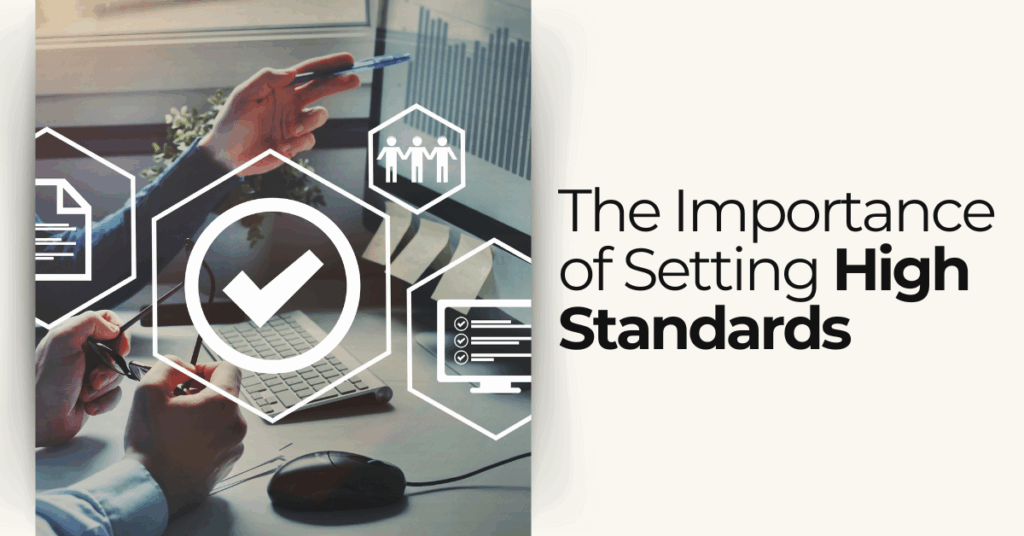
The Importance of Setting High Standards
Here’s a powerful insight.
The quality of your leadership will be reflected in the standards you set for yourself.
This insight is so important that it bears repeating—let me say it again:
The quality of your leadership will be reflected in the standards you set for yourself.
Think about it.
When you, as a Leader of LIGHT, set high standards for yourself, you’re announcing to the world that what you do—and how you do it—matters!
Indeed, you’re putting everyone on notice that only your highest purpose and best effort will do.
And this message has enormous leadership implications.
How so?
Put simply: the standards you set determine the results you get.
In fact, when your people see that you are striving to live a life that’s guided by a set of high standards, they’ll follow suit.
And when they do, the sky’s the limit.
Like I said, powerful.
5 Reasons Why You Need to Set High Standards for Yourself
Here are 5 reasons why setting high standards are important for you, your people, and your organization:
1. High standards drive performance and results.
First, high personal standards encourage you to strive for excellence—day in and day out. This striving naturally leads to improved performance and better outcomes. And when those around you see that their leader is devoted to continuous improvement, they get religion.
2. High standards create a culture of accountability.
When you, as a Leader of LIGHT, set high standards for yourself (and hold yourself accountable), it demonstrates that you are serious about moving the organization forward. This fosters a culture of responsibility when others decide to jump on the bus.
3. High standards motivate and inspire teams.
Watching a leader strive to achieve a high set of standards is flat-out motivating—especially when the leader is smart enough to couple it with an opportunity for recognition and rewards. In the words of John Maxwell, “Great leaders know the way, show the way, and go the way.”
4. High standards enhance team cohesion and morale.
When team members recognize that they are being led by a high-performing leader, they instinctively want to become part of a high-performing team. When this happens, morale skyrockets.
5. High standards build a strong reputation.
Last but not least, leaders who are known for their high standards often have organizations that have enduring reputations for innovation, quality, and excellence—all of which attract customers, investors, and top talent.
A Shining Example of High Standards
Bill Russell was arguably the greatest basketball player ever to play the game. In fact, Russell won 11 NBA championships in 13 seasons. In addition, he was a five-time NBA MVP and a 12-time All-Star.
As you might guess, Russell was known for his ridiculously high standards, his dedication to self-improvement, and his focus on maximizing his contribution to team success.
What’s more, he was highly analytical of his own performance and constantly sought to improve.
Here’s a great example:
After every single game that Russell ever played, he would rate his performance on a scale of 100.
The highest grade he ever gave himself?
65.
Here’s the point:
His post-game self-evaluations were a way for him to identify areas where he fell short and to strive for that “perfect game” he never felt he achieved.
Russell’s success highlights the power of setting high standards and relentlessly pursuing excellence.
NEWSFLASH: Setting High Standards Also Includes Digital Devices
Believe it or not, one of the most commonly overlooked areas for setting high standards relates to the use of digital devices.
This is somewhat surprising, because digital devices are so common within our organizations today.
But without a set of high standards, unchecked digital device use can fracture focus, reduce productivity, increase accidents, harm relationships, and inhibit interaction.
So, what’s a leader to do?
Three Key Questions to Set High Standards Around Your Digital Device Use
To maximize the use of digital devices in your organization, we encourage you to ask yourself (and your teammates) three important questions:
1. What relationship do I want to have with my digital device?
2. In what circumstances will I silence my digital device?
3. In what circumstances will I stow my digital device in another room?
By posing these three questions to you and your team, you are letting everyone know that there is a time and a place for the appropriate use of digital devices. And by adhering to the standards that you and your team set, you can rest easy knowing that your digital devices will be serving you and not vice-versa.
Leading with LIGHT
Three words: high standards matter.
In fact, great leaders make no apology for setting high standards. To be sure, high standards drive peak performance.
With this in mind, it’s also important to understand that high standards should absolutely be applied to the use of digital devices within your organization.
Remember, your smartphone has significantly more processing power (and memory) than the computers used in NASA’s Apollo XI rocket.
Yep, the one that landed on the moon in the summer of 1969. (I’m not kidding, Google it.)
Here’s a way to make sense of this.
Your smartphone is like a powerful heating system in a big building. If you use it right, you can heat the whole place.
If you use it wrong, you can burn everything to the ground.
And that’s why the three questions we highlighted earlier are essential if you want to maximize your impact as a Leader of LIGHT—especially when it comes to the appropriate use of digital devices in your daily pursuit of excellence.
Until next time, See LIGHT. Be LIGHT. Spread LIGHT.
Until Next Time...
We’ve picked some articles we think you might like! Click below to read more.

If You Want to Lead, You Have to Read
As a Leader of LIGHT, you have an important challenge ahead of you: You have to grow yourself, and at the same time, you have to grow everyone around you. Balancing these two tasks can be very difficult.

The Importance of Texting Less and Talking More
Clinical psychologist Catherine Steiner-Adair said it best, “…Texting is the worst possible training ground for anyone aspiring to a mature, loving, sensitive relationship.”

Do You Know How to Guard Your Focus?
These days, it’s not uncommon to wonder if your attention span is getting worse.
If you feel this way, you aren’t wrong. And you aren’t alone.
About Lead with Light
Lead with Light is an initiative that aims to equip current and emerging leaders with a reimagined approach to servant leadership.
Our ultimate vision is to grow and develop thousands of Leaders of Light to ignite a movement to see light, be light, and spread light in ways only each can.


